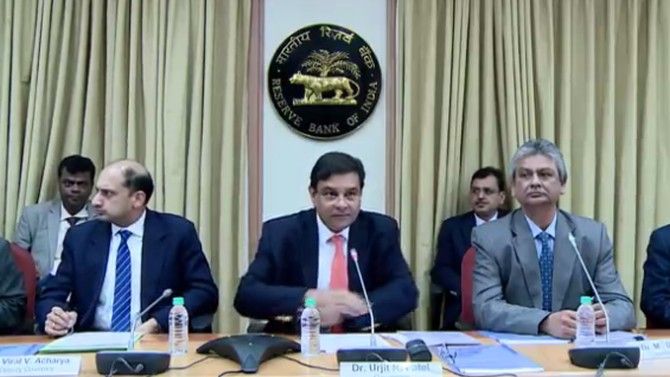 | « Back to article | Print this article |
There is a narrow chance that the central bank may cut rates in the future, according to a poll of 15 economists and treasurers.

There is a clear consensus that the six-member monetary policy committee of the Reserve Bank of India would keep the repo rate unchanged at 6 per cent next week.
But surprisingly, there is a narrow chance that the central bank may cut rates in the future, according to a Business Standard poll of 15 economists and treasurers.
This is an emergent view, which was missing in previous polls undertaken by Business Standard. Surely, any change in rates or stance is not expected in the first bi-monthly monetary policy review for 2018-19 on April 4-5. But the inflation trajectory has surprised many and stagnant growth could compel the RBI to go for a rate cut, according to some economists.
The consumer price index (CPI)-based inflation in February came at 4.4 per cent, below the RBI’s March projection of 5.1 per cent. The inflation rate is likely to fall further in March. The sharper-than-anticipated fall in prices opens up the space for the central bank to cut rates, especially at a time when growth is not expected to pick up sharply.
“The recent inflation print (numbers) has been a positive surprise, so the MPC will be in wait-and-watch mode. They might revise their march inflation estimates,” said Abheek Barua, chief economist of HDFC Bank. Barua expects a "contractional stance from a neutral stance" and a hike in the later part of the next financial year.
Soumya Kanti Ghosh, group chief economist of SBI Group, expects the inflation rate to fall to 3.5 per cent. This gives the central bank the chance to be more accommodative and offer a 25 basis point rate cut this calendar year, he added.
But only two of the 15 people polled mentioned about a rate cut. Among those who offered a clear view, six expect at least a 25 basis point hike in the coming months, and four said there would be a prolonged pause.
“We are in for a pause for the next six months and beyond that depending on data on food prices, inflation and global crude oil prices. There are a lot of moving parts and expect only one rate hike for the full year,” said D K Joshi, chief economist of Crisil.
In the absence of a policy rate action, the importance shifts to what the policy statement offers.
“We will be mainly looking at inflationary forecasts, given the concerns raised in the last meeting. We expect a hike of 50 basis points in the RBI's policy rate throughout this year,” said A Prasanna, chief economist of ICICI Securities Primary Dealership.
In is February policy, the central bank revised its inflation outlook upward at 5.1 per cent for the March quarter, higher than its earlier forecast of 4.3-4.7 per cent in the second half of 2017-18. In the first half of 2018-19, retail inflation would be in the range of 5.1-5.6 per cent, but may cool down to 4.5-4.6 per cent in the second half, according to the earlier projection.
The inflation outlook was clouded by several uncertainties on the upside, including a staggered rise of house rent allowance by state governments, rising crude oil prices, and increase in prices of crops due to the hike in minimum support prices. Increase in the customs duty and the government’s fiscal slippage were other risks, the RBI had said.
Upasna Bharadwaj, senior economist at Kotak Mahindra Bank, said she would look for an indication of increase in the investment limit of foreign portfolio investors (FPI) in debt. FPIs are allowed to invest up to 5 per cent in government debt, but that limit is expected to be increased in the coming months.
“More than the monetary policy, the minutes would be interesting. We would want to see what RBI Executive Director Michael Patra would say on inflation. We expect him to vote for a sharp hike,” said a senior economist polled.
The policy would also be keenly watched for its clarification on the bond market and liquidity. The deficit in system liquidity is close to around Rs 700 billion now.
“It is a trilemma for the RBI to manage liquidity, creating adequate demand for government bonds and adopting an appropriate interest rate stance,” SBI’s Ghosh said.
“The central bank needs to support demand for bonds by appropriate and symmetrical liquidity management policies. With the current policy of permanent liquidity withdrawal, but only temporary liquidity injection, the bond market would be characterised by typical and undesirable idiosyncrasies, and that could damage the market,” he added.
In principle, even as the statutory liquidity ratio (SLR), currently at 19.5 per cent, has been sought to be reduced, a 7 per cent liquidity coverage ratio (LCR) requirement with a 2 per cent margin forces banks to hold at least 28.5 per cent SLR now. This in turn has created a fundamental demand supply imbalance of bonds and until and unless the RBI acknowledges this problem, the recent decline in yield could still be premature, bond dealers said.